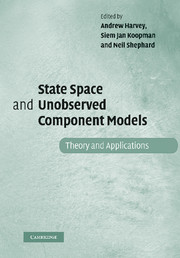Book contents
- Frontmatter
- Contents
- Preface
- Acknowledgements
- Part I State space models
- Part II Testing
- Part III Bayesian inference and bootstrap
- Part IV Applications
- 10 Measuring and forecasting financial variability using realised variance
- 11 Practical filtering for stochastic volatility models
- 12 On RegComponent time series models and their applications
- 13 State space modelling in macroeconomics and finance using SsfPackin S+Finmetrics
- 14 Finding genes in the human genome with hidden Markov models
- References
- Author index
- Subject index
10 - Measuring and forecasting financial variability using realised variance
Published online by Cambridge University Press: 06 January 2010
- Frontmatter
- Contents
- Preface
- Acknowledgements
- Part I State space models
- Part II Testing
- Part III Bayesian inference and bootstrap
- Part IV Applications
- 10 Measuring and forecasting financial variability using realised variance
- 11 Practical filtering for stochastic volatility models
- 12 On RegComponent time series models and their applications
- 13 State space modelling in macroeconomics and finance using SsfPackin S+Finmetrics
- 14 Finding genes in the human genome with hidden Markov models
- References
- Author index
- Subject index
Summary
Abstract
We use high frequency financial data to proxy, via the realised variance, each day's financial variability. Based on a semiparametric stochastic volatility process, a limit theory shows you can represent the proxy as a true underlying variability plus some measurement noise with known characteristics. Hence filtering, smoothing and forecasting ideas can be used to improve our estimates of variability by exploiting the time series structure of the realised variances. This can be carried out based on a model or without a model. A comparison is made between these two methods.
Introduction
Neil Shephard was fortunate to have Jim Durbin as his supervisor and time series teacher during his first year of graduate studies at the London School of Economics (LSE) in 1986–7. It was just before Jim retired. Jim was very interested in state space models, having recently written the Harvey and Durbin (1986) influential seat-belt case study on structural time series models.
Ole Barndorff-Nielsen's main contact with the research work of Jim Durbin has been with his pathbreaking paper Durbin (1980). Together with the papers by Cox (1980) and Hinkley (1980), this was of key import for the discovery of the general form of the p*-formula for the law of the maximum likelihood estimator and hence the development of the theory that has flown from that formula (see Barndorff-Nielsen and Cox (1994) and the survey paper by Skovgaard (2001)).
Jim's research has had a profound impact on statistics and econometrics. From modelling, estimating and testing time series models to instrumental variables and general estimating equations, through to modern distribution theory, his work has been characterised by energy and inventiveness. He has an original mind.
- Type
- Chapter
- Information
- State Space and Unobserved Component ModelsTheory and Applications, pp. 205 - 235Publisher: Cambridge University PressPrint publication year: 2004
- 8
- Cited by



